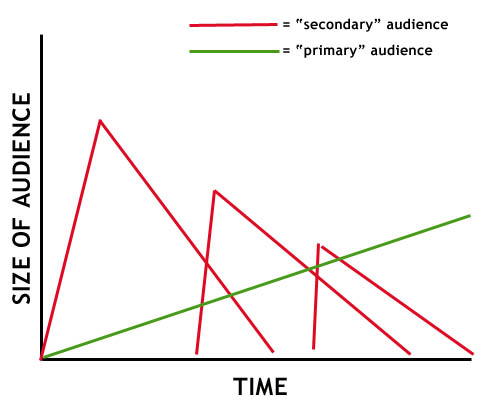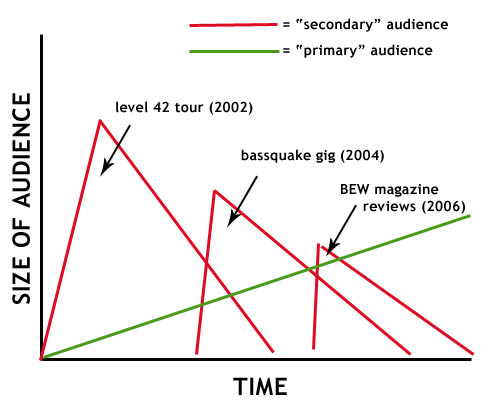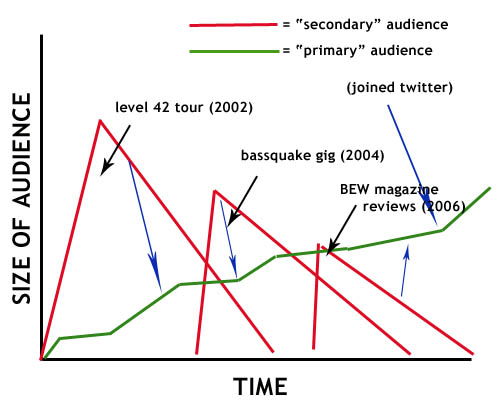Today, we’re going to be looking at graphs. Here’s the basic premise:
So, something I noticed a long time ago (and I’m sure a lot of people noticed a long time before me) is that the kind of audience you pick up from ‘other people’s activity’ – whether that be support gigs, radio airplay, magazine reviews… – ALWAYS gets smaller:
- You get exposed to a load of people,
- a small proportion of them dig what you do
- another percentage of those stop listening to you after a short while once the novelty wears off or something new comes along to grab their attention. Let’s call this your ‘secondary audience‘.
Contrast that with your primary audience, where the audience is made up of people that you have connected with, personally.
- People you’ve met,
- people you’ve had email conversations with,
- even people who you’ve had myspace chats with…
This audience, in my experience, continues to grow, albeit much more slowly than any one event in the secondary category.
Let’s have a look at some examples from my career:
So here we have three randomly chosen events from my solo career thus far. The Level 42 tour was by quite some margin the biggest live exposure I’ve had. It earned me a whole lot of money (largely thanks to the PRS royalties I got paid for playing my own tunes), but didn’t come away with tens of thousands of new fans. The raw stats would show the following
- that about half the people who bought tickets for those shows didn’t see me play at all (they stayed in the bar, or turned up just in time for Level 42),
- another chunk of them wouldn’t really have registered that anyone was playing – I was the opening act, and as such, at some of the gigs, people just talked through it
- Another audience group will have enjoyed it, but been happy to leave it at that – entertainment, but not something they wanted to follow up.
- Yet more will have actually disliked it – some will have gone to the bar after I started, others stayed just to torture themselves with the horrible noises 😉 .
- A surprisingly (to me) large number of them liked it enough to come and buy CDs after the gigs.
But here’s the observation: of those that bought CDs then, the ones I hear from most now, and who most often post nice things about me on the internet are those I actually met and spoke to out on by the CD table. After ever gig, I went out and met as many people who wanted to come and say hi as I could. I signed autographs, chatted, gave impromptu bass technique and looping Q&As, even picked up a few new students.
Same for the various bassquake events I’ve played at – I’ve played to THOUSANDS of bass-monkeys at NAMM show gigs. Had rapturous applause, even been told I was ‘best in show‘ (WTF?) by some. But again, the people I had conversations with are the ones I still hear from, the ones who buy my music, the ones who tell their friends.
So this third graph is the key one:
The blue arrows here represent those who moved from the secondary to the primary audience – those people I met through whichever event it was. Notice to slightly ‘laddered’ shape to the green line – each time a load of people move from one to the other, there’s a slight upturn in the speed of growth. It’s a much slower growth from press/radio coverage than it is from gigs, mainly because the value of press reviews if you’re not already ubiquitous is largely in validating the taste of those who already like you but aren’t sure if it’s OK to like you, and with radio, it takes a fair amount of effort to actually look up the great music you just heard…
And just to put it in a social media context – the last upturn happened when I joined Twitter. This is because the primary connection happened BEFORE people had even heard my music. As I keep saying, they found me cos I was interesting, not good, and then listened, having discovered it in an environment built for feedback, interaction and sharing. So every time someone finds out about me on Twitter, they tell their friends, and post a link with my username in it – effectively, a link back to the source.
Again, the take-away is that a healthy music career has both/and not either/or. But the transition – those blue arrows – are the REALLY important statistic here, not how high the red spikes are.




Very thoughtful and thougt provoking analysis Steve. Any insight as to where your blog(s) have added to your secondary or primary audience?
Are the readers already part of your audience?
Keep making music!
Interesting! I’ve shared this on my FB page. Cheers!
Hey Steve, I think you are interesting AND good! 🙂 You are correct, though. I first became aware of you through Twitter just because I was searching for interesting, knowledgeable people and your profile kept popping up. Then I finally checked out your music and was very impressed with the very high level of artistic integrity and creative energy.
That did not happen through any traditional music magazine or even a concert or club situation—it was just the fact that you are posting about topics that are relevant to everyone involved in social networking, not only speaking to musicians.
Good post Steve. You are right that the Blue Arrow Citizens (name of a band surely?!) are critical. Sadly too many artists, managers and labels think short-termist. Do the tour, get the short-term cash. Limited Edition vinyl single – short term bump. Brand takes your music for an ad – short-term pay-day…
Their focus is on what you call the Secondary Audience.
The problem manifests itself in the mentality that is stuck in ‘OUT NOW’ mode. The switch to ‘OUT ALWAYS’ mode, one that you clearly made some time ago, is something that defeats too many people. Your chart is a lovely way to help people make the switch. I will post up over on the citizensound blog…